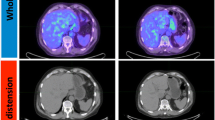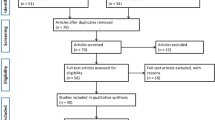Abstract
Background
Unexpected hypermetabolic activity is often encountered in the gastrointestinal tract when PET/CT is performed for various indications, prompting endoscopic evaluation. Our aim was to characterize the types of lesions seen in segments of the gastrointestinal tract with unexpected PET/CT abnormalities as well as clinically significant lesions seen on endoscopy which did not produce a PET/CT abnormality to guide the endoscopist tasked with evaluating these imaging findings.
Methods
We retrospectively reviewed a database of endoscopies performed at City of Hope Comprehensive Cancer Center between January 1, 2016 and September 30, 2021 for an indication of “abnormal PET.” We divided the gastrointestinal tract into segments and defined categories of endoscopic/histologic findings for each segment. We counted the number of segments with an abnormal PET/CT finding and corresponding endoscopic/histologic abnormality as well as the number of segments with an endoscopic/histologic abnormality but normal PET/CT.
Results
PET/CT identified 209 segments with hypermetabolic activity, 109 of which had corresponding endoscopic/histologic abnormalities. In the jejunum and ileum, all corresponding lesions were malignant. Seventy-three percent of corresponding lesions in the stomach were H. pylori positive. PET/CT failed to detect 34.7% of clinically significant lesions diagnosed endoscopically, including 1 malignancy in the transverse colon and many inflammatory or low-risk premalignant lesions.
Conclusion
PET/CT abnormalities seen in the small bowel should be evaluated urgently as nearly all correlates were malignant, while abnormalities in the stomach should prompt workup for H. pylori. Most lesions missed by PET/CT were inflammatory or low-risk premalignant yet clinically significant, confirming the need to inspect the entirety of the upper or lower gastrointestinal tract during endoscopy.




Similar content being viewed by others
References
Kamel EM, Thumshirn M, Truninger K, Schiesser M, Fried M, Padberg B, Schneiter D, Stoeckli SJ, von Schulthess GK, Stumpe KD. Significance of incidental 18F-FDG accumulations in the gastrointestinal tract in PET/CT: correlation with endoscopic and histopathologic results. J Nucl Med 2004;45:1804–1810.
Israel O, Yefremov N, Bar-Shalom R, Kagana O, Frenkel A, Keidar Z, Fischer D. PET/CT detection of unexpected gastrointestinal foci of 18F-FDG uptake: incidence, localization patterns, and clinical significance. J Nucl Med 2005;46:758–762.
Ravizza D, Bartolomei M, Santoro L, Tamayo D, Fiori G, Trovato C, De Cicco C, De Roberto G, Paganelli G, Crosta C. Positron emission tomography for the detection of colorectal adenomas. Dig Liver Dis 2010;42:185–190.
Luboldt W, Volker T, Wiedemann B, Zophel K, Wehrmann U, Koch A, Toussaint T, Abolmaali N, Middendorp M, Aust D et al. Detection of relevant colonic neoplasms with PET/CT: promising accuracy with minimal CT dose and a standardised PET cut-off. Eur Radiol 2010;20:2274–2285.
Weston BR, Iyer RB, Qiao W, Lee JH, Bresalier RS, Ross WA. Ability of integrated positron emission and computed tomography to detect significant colonic pathology: the experience of a tertiary cancer center. Cancer 2010;116:1454–1461.
Kei PL, Vikram R, Yeung HW, Stroehlein JR, Macapinlac HA. Incidental finding of focal FDG uptake in the bowel during PET/CT: CT features and correlation with histopathologic results. AJR Am J Roentgenol 2010;194:W401-406.
Gutman F, Alberini JL, Wartski M, Vilain D, Le Stanc E, Sarandi F, Corone C, Tainturier C, Pecking AP. Incidental colonic focal lesions detected by FDG PET/CT. AJR Am J Roentgenol 2005;185:495–500.
Goldin E, Mahamid M, Koslowsky B, Shteingart S, Dubner Y, Lalazar G, Wengrower D. Unexpected FDG-PET uptake in the gastrointestinal tract: endoscopic and histopathological correlations. World J Gastroenterol 2014;20:4377–4381.
Hosni MN, Kassas M, Itani MI, Rahal MA, Al-Zakleet S, El-Jebai M, Abi-Ghanem AS, Moukaddam H, Haidar M, Vinjamuri S et al: The Clinical Significance of Incidental GIT Uptake on PET/CT: Radiologic, Endoscopic, and Pathologic Correlation. Diagnostics (Basel) 2023, 13.
Gilhotra RA, Song L, Remedios M, Malacova E, Appleyard M, Ryan K, Grimpen F. Clinical significance of incidental (18) FDG PET uptake in the gastrointestinal tract: a retrospective cohort study. Intern Med J 2023;53:1670–1677.
Kousgaard SJ, Gade M, Petersen LJ, Thorlacius-Ussing O. Incidental detection of colorectal lesions on (18) F-FDG-PET/CT is associated with high proportion of malignancy: A study in 549 patients. Endosc Int Open 2020;8:E1725–E1731.
Pandit-Taskar N, Schoder H, Gonen M, Larson SM, Yeung HW. Clinical significance of unexplained abnormal focal FDG uptake in the abdomen during whole-body PET. AJR Am J Roentgenol 2004;183:1143–1147.
Valente MA. Endoscopic and histopathological analysis of incidental focal colorectal. Am J Surg 2018;215(3):379–381.
van Kouwen MC, Nagengast FM, Jansen JB, Oyen WJ, Drenth JP. 2-(18F)-fluoro-2-deoxy-D-glucose positron emission tomography detects clinical relevant adenomas of the colon: a prospective study. J Clin Oncol 2005;23:3713–3717.
Esmer AC, Oksuzoglu K, Sen F, Yazici H, Tazeoglu D, Ergelen R, Ones T, Yegen SC. Evaluation of Colonoscopic Results of Patients with Incidental Colonic FDG Uptake in PET/CT Imaging. World J Surg 2023;47:2532–2541.
Kobayashi S, Ogura M, Suzawa N, Horiki N, Katsurahara M, Ogura T, Sakuma H: 18F-FDG uptake in the stomach on screening PET/CT: value for predicting Helicobacter pylori infection and chronic atrophic gastritis. BMC Medical Imaging 2016, 16.
Cronin CG, Swords R, Truong MT, Viswanathan C, Rohren E, Giles FJ, O’Dwyer M, Bruzzi JF. Clinical utility of PET/CT in lymphoma. AJR Am J Roentgenol 2010;194:W91–W103.
Skrypets T, Ferrari C, Nassi L, Margiotta Casaluci G, Puccini B, Mannelli L, Filonenko K, Kryachok I, Clemente F, Vegliante MC et al: 18F-FDG PET/CT Cannot Substitute Endoscopy in the Staging of Gastrointestinal Involvement in Mantle Cell Lymphoma. A Retrospective Multi-Center Cohort Analysis. J Pers Med 2021, 11.
Albano D, Ferro P, Bosio G, Fallanca F, Re A, Tucci A, Maria Ferreri AJ, Angelillo P, Gianolli L, Giubbini R et al. Diagnostic and Clinical Impact of Staging (18)F-FDG PET/CT in Mantle-Cell Lymphoma: A Two-Center Experience. Clin Lymphoma Myeloma Leuk 2019;19:e457–e464.
Schuster DM, Nanni C, Fanti S, Oka S, Okudaira H, Inoue Y, Sorensen J, Owenius R, Choyke P, Turkbey B et al. Anti-1-amino-3-18F-fluorocyclobutane-1-carboxylic acid: physiologic uptake patterns, incidental findings, and variants that may simulate disease. J Nucl Med 2014;55:1986–1992.
Funding
None.
Author information
Authors and Affiliations
Contributions
HT, TK, SD: Study design, data collection, data analysis, manuscript drafting. AR, JKL, JL: Study design, manuscript review. SM, RM: Review and interpretation of radiographic studies, manuscript review. YL: Review of histology, manuscript review.
Corresponding author
Ethics declarations
Conflict of interest
None.
Additional information
Publisher's Note
Springer Nature remains neutral with regard to jurisdictional claims in published maps and institutional affiliations.
Rights and permissions
Springer Nature or its licensor (e.g. a society or other partner) holds exclusive rights to this article under a publishing agreement with the author(s) or other rightsholder(s); author self-archiving of the accepted manuscript version of this article is solely governed by the terms of such publishing agreement and applicable law.
About this article
Cite this article
Trieu, H., De Silva, S., Manoukian, S. et al. Endoscopic Evaluation of PET/CT Abnormalities in the Gastrointestinal Tract: Yield and Approach. Dig Dis Sci 69, 552–561 (2024). https://doi.org/10.1007/s10620-023-08231-6
Received:
Accepted:
Published:
Issue Date:
DOI: https://doi.org/10.1007/s10620-023-08231-6




